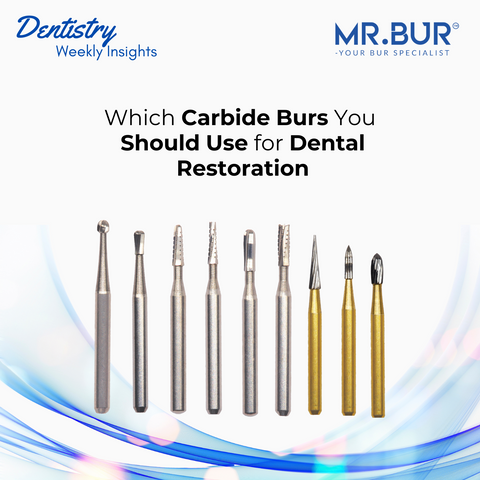Diamond burs are a staple in every dental practice, essential for a variety of procedures from cavity preparation to finishing restorations. The quality of your burs can greatly influence the precision and efficiency of your work. As a dentist with over a decade of experience, dental professionals have found that investing in the right diamond burs can make all the difference. Here are the top nine essential diamond burs that every dentist should consider adding to their toolkit.
1. 801 Round Diamond Burs
Application: Round diamond burs are among the most versatile and commonly used burs in dentistry. Their spherical shape makes them perfect for accessing areas that require precision, like initial cavity preparations and creating rounded internal line angles.
Uses:
- Excavation of caries
- Access cavity creation for root canals
- Removing small amounts of enamel for minor adjustments
Advantages: The small, rounded shape offers excellent control when removing tooth material, ensuring you don’t damage surrounding structures. In my own practice, I often turn to round diamond burs for starting cavities as they allow for a gentle, controlled entry into the tooth without risk of overcutting.
2. 845 / 855 Tapered Diamond Burs
Application: Tapered diamond burs are ideal for creating precise cuts and shaping, especially in crown preparations. The tapered design allows for the creation of smooth, contoured surfaces.
Uses:
- Occlusal reduction during crown prep
- Shaping and smoothing margins
- Refining restorations for a precise fit
Advantages: Tapered burs provide excellent control, especially when working on the fine margins of a crown or veneer. In challenging restorative cases, such as preparing a molar for a crown, these burs make it easy to achieve the precise angle needed for a perfect fit.
3. 830 Pear-Shaped Diamond Burs
Application: Pear-shaped burs are designed for efficient tooth structure removal while maintaining as much healthy tissue as possible. They are often used in cavity preparations and occlusal reduction.
Uses:
- Cavity preparation, especially in Class I and Class II restorations
- Occlusal surface reduction
- Efficient material removal
Advantages: This bur allows for a balance between material removal and conservation of healthy tooth structure. In cases of moderate decay, the pear-shaped bur has helped me create a smooth, natural shape in the cavity preparation without weakening the surrounding enamel.
4. 862 Flame-Shaped Diamond Burs
Application: Flame-shaped diamond burs are perfect for contouring and finishing. Their long, narrow design allows for easy access to tight or interproximal areas, making them ideal for precise trimming and polishing.
Uses:
- Polishing and refining crown and veneer margins
- Trimming excess material in restorative procedures
- Shaping gingival margins in cosmetic dentistry
Advantages: Flame-shaped burs are excellent for detailed work, such as refining the edges of veneers or crowns. In my cosmetic cases, I rely on this bur to give restorations a seamless transition between the tooth and the restoration material.
5. 835 Cylinder Diamond Burs
Application: Cylinder diamond burs are best for large surface reductions and creating flat surfaces. Their cylindrical shape ensures a uniform reduction of material across wide areas.
Uses:
- Large restorations or crown preparations
- Occlusal surface reduction
- Preparing flat surfaces for bonding
Advantages: Cylinder diamond burs allow for even reduction, especially when working on larger surfaces. They are ideal for full-coverage crowns where significant material removal is needed. The smooth, flat surfaces they create help ensure that restorations bond securely.
6. Needle Diamond Burs
Application: Needle diamond burs are designed for fine, delicate work, particularly in tight or narrow spaces. Their narrow, elongated design makes them perfect for interproximal access.
Uses:
- Interproximal contouring
- Delicate adjustments in crowded areas
- Accessing and trimming small cavities
Advantages: Needle burs offer unparalleled precision in tight spaces. I often use needle burs when contouring between teeth or working on tight spaces in orthodontic treatments, ensuring that no material is missed, and the finish is smooth.
7. 852 Pointed Cone Diamond Burs
Application: Pointed cone diamond burs are ideal for trimming and finishing. Their conical shape provides a smooth taper for refining preparations, especially when removing excess material.
Uses:
- Crown preparation and trimming
- Refining the edges of restorations
- Preparing composite fillings
Advantages: The shape of pointed cone burs allows for precision in contouring and cutting through tough materials. The cone-shaped burs are especially helpful when preparing a tooth for a crown, as they allow for a smooth finish and accurate fit.
8. 805 Inverted Cone Diamond Burs
Application: Inverted cone diamond burs are commonly used for creating undercuts and sharp angles in cavity preparations. The flat-topped design makes it easy to create precise cuts.
Uses:
- Creating undercuts in cavity preparations
- Refining occlusal surfaces
- Preparing for restorative materials
Advantages: Inverted cone burs are excellent for shaping retention areas in cavity preparations, particularly in cases where sharp angles are needed to secure a filling. Their unique shape has allowed me to create more retentive preparations, ensuring restorations stay secure over time.
MR. BUR Australia provides a wide range of dental burs globally.
Diamond Burs, Carbide Burs, Surgical & Lab Use Burs, Endodontic burs, IPR Kit, Crown Cutting Kit, Gingivectomy Kit, Root Planning Kit, Orthodontic Kit, Composite Polishers, High Speed Burs, Low Speed Burs
Subscribe our newsletter now!










